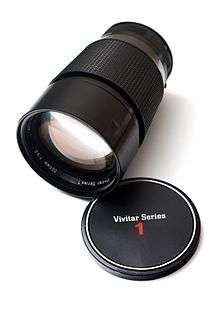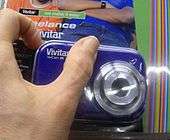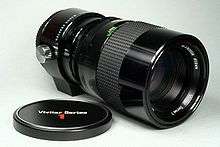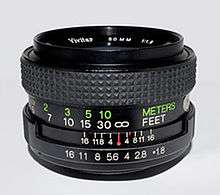Vivitar
Vivitar Corporation was a manufacturer, distributor and marketer of photographic and optical equipment originally based in Santa Monica, California. Since 2008 the Vivitar name serves as Sakar International's house brand for digital imaging, optics, mobile accessories, and audio products.
Products
The company's product line has included 35 mm SLR cameras, zoom lenses, flashes, film enlargers, binoculars, digital cameras, night vision products, point-and-shoot cameras, tripods, underwater cameras, and other photographic accessories.
History

The company was founded in 1938 as Ponder and Best by Max Ponder and John Best. Max Ponder headed the sales department, while John Best ran the operations side of the company. Ponder and Best first imported German-made photo equipment. After World War II, the partnership began to import cameras and photographic equipment from Japan. They were instrumental in the introduction of many brands into the American market, including Mamiya/Sekor 35mm cameras, Kobena 8mm movie cameras, Sankyo/Komura wide/tele adapter lenses and a full line of photographic darkroom equipment imported from many manufacturers throughout Japan and later Taiwan. Ponder and Best were the first to gain acceptance for lenses with interchangeable mounts allowing customers to use the same lens on different manufacturers' camera bodies.
In the early 1960s, the partners created the "Vivitar" brand to compete with major lens manufacturers. The company commissioned experienced lens designers and top-line Japanese optical lens manufacturers such as Kino Precision to produce their lens designs. By carefully positioning their limited product line with key photo retailers, they quickly built a reputation for good quality lenses at modest prices. The retailers found that they could make good margins while giving good value. As their reputation grew, many contract lens manufacturers sought them out to carry their products under the Vivitar brand. In the 1970s, Vivitar introduced its now-famous Series 1 lenses. These computer-designed state-of-the-art lenses were well priced and often outperformed the optics of camera manufacturers of the day.
After the success of its aftermarket lens line, Vivitar later introduced its own line of 35mm film cameras manufactured by Japanese companies such as Cosina. These include the Cosina-made Vivitar SLR and the Vivitar 35ES/EE series of rangefinder cameras.
Vivitar also offered a new type of semi-professional flash unit from National/Panasonic under the Vivitar label called the Vivitar 260. The flash was acclaimed for its innovative design, but criticized for its use of expensive 9 volt batteries. Recognizing the problem, Max Ponder travelled to Japan to meet with the manufacturer, offering suggestions for improvements based on the feedback received from customers. The improved flash was introduced in 1970 as the Vivitar 283. The Vivitar 283 quickly became the number one professional and enthusiast flash unit, outselling all its competitors combined and selling 3,000,000 by 1973. In production for over 30 years, it was twice returned to production after being discontinued in response to customer demand. The 283's sister flash was called the 285, and featured a zoom head to cover different focal length lenses and a built-in variable power setting. Earlier made-in-Japan Vivitar flashes have a trigger voltage of 250v, which can damage the circuits of some digital cameras. Newer units made in China and Korea are low-voltage units producing 5 to 12 volts. A point of note is the 283 has a removable sensor (as has the 285) and coupled the optional remote sensor cord, off-camera flash is possible with the gun still in auto mode.
After the deaths of Max Ponder and John Best, company ownership was transferred to a variety of owners. Some digital compact cameras were launched but were not successful. In November 2006, the corporation was purchased by public company Syntax-Brillian Corporation for US $26 million in stock and was operated as a wholly owned subsidiary.[1] On August 21, 2008, subsequent to its filing for bankruptcy, parent company Syntax-Brillian completed the sale of the Vivitar brand name and intellectual property to privately held consumer electronics maker Sakar International, based in Edison, New Jersey. Sakar did not purchase Vivitar’s equipment, facilities or accounts receivable. Terms of the deal were not disclosed.[2]
Current Vivitar operations

In August 2008, Sakar announced plans to position Vivitar as a brand for its current mass retail digital cameras in the midprice range of $70–$300, along with certain camera accessories. New Vivitar-branded products such as digital photo frames are also planned, as well as potential licensing opportunities.[3][4] In January 2009 Sakar introduced 3 new Vivitar-branded cameras and a digital SLR lens series. The products are Sakar's first Vivitar-branded SKU's since Sakar acquired the Vivitar brand.[5] In addition to other electronics products, in 2013, they announced and then shipped the $150 XO Tablet, a 7-inch Android tablet designed for children, with a bilingual English/Spanish interface.[6][7]
Vivitar lenses

Manual focus prime lenses


- Vivitar Series 1 7mm f/3.5 Fish-eye CS (for APS-C digital sensors only, a rebadged Samyang 8mm f/3.5 from 2009)
- Vivitar Series 1 13mm f/2.8 (rebadged Samyang 14mm f/2.8, released in 2010)
- Vivitar 17mm f/3.5 (made by Tokina)
- Vivitar 19mm f/3.8 (made by Cosina)
- Vivitar 20mm f/3.8 (82mm filter, made by Kiron)
- Vivitar 21mm f/3.8 T4 (made by Tokina)
- Vivitar 24mm f/2 (52mm filter version made by Komine, 55mm made by Kiron)
- Vivitar 24mm f/2.8 (Cosina)
- Vivitar 24mm f/2.8 T4 (67mm filter, made by Tokina)
- Vivitar 24mm f/2.8 TX (58mm filter, made by Tokina)
- Vivitar Series 1 28mm f/1.9 (made by Tokina)
- Vivitar 28mm f/2 "Close Focus"(49mm filter version made by Komine)
- Vivitar 28mm f/2 (55mm by Kiron)
- Vivitar 28mm f/2.5 (62mm or 67mm filter, made by Kiron)
- Vivitar 28mm f/2.5 TX (58mm filter, made by Tokina)
- Vivitar 28mm f/2.8 T4 (58mm filter, made by Tokina)
- Vivitar Close Focus 28mm f/2.8
- Vivitar 28mm f/2.8 (made by Komine)
- Vivitar 28mm f/2.8 TX (made by Tokina)
- Vivitar 35mm f/1.4 (made by Samyang, released in 2011)
- Vivitar 35mm f/1.9 (made by Komine)
- Vivitar 35mm f/2.5 TX (made by Tokina)
- Vivitar 35mm f/2.8
- Vivitar 35mm f/2.8 T4 (made by Tokina)
- Vivitar 50mm f/1.4 VMC (49mm filter made by Cosina)
- Vivitar 50mm f/1.7 (Cosina)
- Vivitar 50mm f/1.8 (Cosina)
- Vivitar 50mm f/1.9 (Cosina)
- Vivitar 50mm f/2.0 (49mm filter)
- Vivitar 55mm f/1.2 VMC (Cosina)
- Vivitar 55mm f/2.8 Macro (made by Komine)
- Vivitar Series 1 85mm f/1.4 Aspherical IF (made by Samyang, released in 2009)
- Vivitar 85mm f/1.8 T-mount
- Vivitar 90mm f/2.5 Macro (1:1 macro, made by Komine)
- Vivitar 90mm f/2.8 Macro (1:1 macro, made by Komine)
- Vivitar Series 1 90mm f/2.5 1:2 Macro, 1:1 achieved with dedicated extender, nicknamed the Bokina (made by Tokina)
- Vivitar 100mm f/2.8 Macro (made by Kiron)
- Vivitar Series 1 105mm f/2.5 macro (1:1 macro, made by Kiron)
- Vivitar 105mm f/2.8 T4 (made by Tokina)
- Vivitar 135mm f/1.5 professional T-mount
- Vivitar Series 1 135mm f/2.3 (made by Komine)
- Vivitar 135mm f/2.5 TX (made by Tokina)
- Vivitar 135mm f/2.8 (made by Komine)
- Vivitar 135mm f/2.8 close-focusing 1:2 Macro (made by Komine)
- Vivitar 135mm f/2.8 T4 & TX (made by Tokina)
- Vivitar 135mm f/3.5 T4 (made by Tokina)
- Vivitar 135mm f/3.5 T-mount
- Vivitar 200mm f/3.5 (early models made by Kiron - later models made by Komine)
- Vivitar 200mm f/3.5 T4 & TX (made by Tokina)
- Vivitar Series 1 200mm f/3 (made by Komine)
- Vivitar Series 1 200mm f/3.5 Auto Focus (made by Cosina)
- Vivitar 250mm f/4.5 T4 (made by Tokina)
- Vivitar 300mm f/5.5 T4 (made by Tokina)
- Vivitar 300mm f/5.6 (made by Olympus)
- Vivitar 300mm f/5.6 (made by Komine)
- Vivitar 400mm f/5.6
- Vivitar 400mm f/5.6 IF TX (made by Tokina)
- Vivitar 400mm f/6.3 T4 (made by Tokina)
- Vivitar Series 1 450mm f/4.5 aspherical mirror T-mount
- Vivitar 500mm f/8
- Vivitar Series 1 500mm f/8 mirror T-mount (released in 2009, made by Samyang)
- Vivitar 500mm f/6.3 T-mount (non-mirror)
- Vivitar 600mm f/8 T-mount (non-mirror)
- Vivitar Series 1 600mm f/8 solid cat T-mount (made by Perkin-Elmer)
- Vivitar Series 1 800mm f/8 mirror T-mount (released in 2009, made by Samyang)
- Vivitar Series 1 800mm f/11 solid cat T-mount (made by Perkin-Elmer)
Manual focus zoom lenses

- Vivitar 17-28mm f/4-4.5 (made by Samyang)
- Vivitar 19-35mm f/3.5-4.5 (made by Cosina)
- Vivitar Series 1 24-48mm f/3.8 (made by Kiron)
- Vivitar Series 1 24-70 f/3.8-4.8 (made by Cosina)
- Vivitar RL edition 28-80mm 1:3.5-4.5 macro focusing zoom MC, 62mm filter size (made by Kobori), (also in RL Edition)
- Vivitar Series 1 28-105mm f/2.8-3.8 (made by Cosina)
- Vivitar 28-200mm f/3.5-5.3 Macro (made by Kobori)
- Vivitar 28-210mm f/3.5-5.6 (made by Cosina)
- Vivitar 28-50mm f/3.5-4.5RL e (made by Komine)
- Vivitar 28-70mm f/3.5-4.8 (made by Cosina)
- Vivitar 28-85mm f/2.8-3.8 (vari-focal zoom, made by Kiron)
- Vivitar 28-85mm f/3.5-4.5 (made by Kobori)
- Vivitar Series 1 28-90mm f/2.8-3.5 (made by Komine)
- Vivitar 35-70mm f/2.8-3.8 (made by Komine)
- Vivitar 35-70mm f/3.5 (made by Komine)
- Vivitar Series 1 35-85mm f/2.8 (Variable focus, made by Kiron)
- Vivitar 35-105mm f/3.5 close focus (fixed-mount & TX, made by Tokina)
- Vivitar 35-200mm f/3-4.5 Macro (made by Kobori)
- Vivitar 55-135mm f/3.5 T4 (made by Tokina)
- Vivitar 70-150mm f/3.8 (1 and 2-touch zoom, made by Kiron)
- Vivitar 70-150mm f/3.8 TX (made by Tokina)
- Vivitar Series 1 70-210mm f/2.8-4 (early version made by Komine, later versions made by Cosina) Lens review
- Vivitar Series 1 70-210mm f/3.5 (67mm version made by Kiron, 62mm version made by Tokina) Lens review
- Vivitar 70-210mm f/4.5 Macro (made by Kobori)
- Vivitar 70-210 f/4-5.6 (made by Cosina)
- Vivitar 75-205 f/3.8 (1 and 2-touch, made by Kiron)
- Vivitar 75-205 f/3.5-4.5 macro focusing (made by Tokina)
- Vivitar 75-260mm f/4.5 T4 & TX (made by Tokina)
- Vivitar 75-300mm f/4.5-5.6 (made by Kobori)
- Vivitar 80-200mm f/4 TX (made by Tokina)
- Vivitar 80-200mm f/4.5 (different models made by Kiron, Komine and Kobori)
- Vivitar 85-205mm f/3.8 (preset T-mount and automatic fixed-mount versions, made by Kiron)
- Vivitar 90-230mm f/4.5 T4 (made by Tokina)
- Vivitar 90-230mm f/4.5 close focus TX (made by Tokina)
- Vivitar Series 1 90-180mm F/4.5 Flat Field zoom (made by Kiron)
- Vivitar 100-200mm f/4 (made by Komine)
- Vivitar 100-300mm f/5 TX (made by Tokina)
- Vivitar Series 1 100-500mm f/5.6-8 (made by Cosina)
- Vivitar Series 1 120-600mm f/8 (made by Kobori) Lens review
- Vivitar Series 1 650-1300mm f/8-16 T-mount (made by Samyang)
Auto focus lenses
- Vivitar Series 1 19-35mm f/3.5-4.5 (made by Cosina)
- Vivitar Series 1 28-70mm f/2.8 (Sigma)
- Vivitar Series 1 28-70mm f/3.5-4.8 SC (self-contained; requires three AAA batteries to operate)
- Vivitar 28-80mm f3.5-5.6
- Vivitar 28-105mm f/2.8-4.0
- Vivitar Series 1 28-210mm f/4.2-6.5
- Vivitar 28-300mm f/4-6.3 (Cosina)
- Vivitar 35-70mm f3.5-4.5
- Vivitar Series 1 75-200mm f/4.5 SC (self-contained; requires three AAA batteries to operate)
- Vivitar Series 1 70-210mm f/2.8 (Sigma)
- Vivitar Series 1 70-210mm f/2.8-4.0
- Vivitar Series 1 70-210mm f/2.8-4.0 APO
- Vivitar 70-210mm f/4.5-5.6 (Cosina)
- Vivitar Series 1 70-300 f/4.5-5.6
- Vivitar 100mm f/3.5 Macro (made by Cosina)
- Vivitar 100-300mm f/5.6-6.7 (Cosina)
- Vivitar 100-400mm f/4.5-6.7 (Cosina)
- Vivitar 200mm f/3.5 (self-contained; requires three AAA batteries to operate) (Komine and Cosina)
Teleconverters
- 1.5x teleconverter
- 2x macro-focusing teleconverter. This unique product featured a helical ring which gave 1:1 magnification when used with a 50mm standard lens.
- 3x teleconverter
See also
References
- ↑ Syntax-Brillian Press Release
- ↑ Sakar Acquires Vivitar Brand, Expanding Footprint in Camera Business Reuters, August 25, 2008
- ↑ Sakar Acquires Vivitar Brand, Expanding Footprint in Camera Business Reuters, August 25, 2008
- ↑ Sakar acquires Vivitar brand and IP, CNET news, August 25, 2008
- ↑ Sakar Rolls Out 3 New Vivitar Cameras & Digital SLR Lens Series January 8, 2009]
- ↑ OLPC announces XO Tablet coming to select Walmart stores later in 2013, by Edgar Alvarez, Engadget, January 8th, 2013
- ↑ XO Tablet Hands On Review: WOW!! OLPC Finally Got It Right!, One Laptop Per Child News, by Wayan Vota on August 4, 2013.
External links
| Wikimedia Commons has media related to Vivitar. |
- Vivitar website
- Archived website showing most recent products offered prior to sale of brand name on 7/21/2008
- Archived website showing most recent products offered prior to sale of brand name on 7/21/2008
- Sakar International website
- Listing of Vivitar camera manuals
- Listing of Vivitar Flash manuals
- Vivitar's Excellent Series One Adventure
- Vivitar 70-210 Series 1 Macro Zooms: Enthusiast web site, historical information
- Vivitar Series 1 200mm f3.0
- History of Vivitar Company
- Vivitar in olypedia.de (extensive illustrated article in German)
- Canon EOS Technoclopedia: Vivitar AF/MF Lenses for Canon EF - a lens chart with technical data, comments and test references